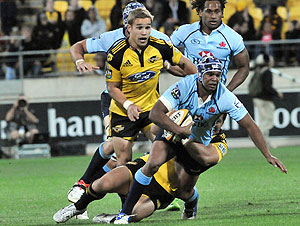
Waratahs Kurtley Beale is taken in a Hurricanes tackle in the Super 14 rugby match at Westpac Stadium, Wellington, New Zealand, Saturday, Feb. 14, 2009. (AAP Images/NZPA, Ross Setford)
When Bob Dwyer was asked what he thought of the five-eighth of the 2005 Australian Schoolboys rugby team, he quipped “that backup five-eighth looks pretty good.” Dwyer was talking about Quade Cooper. The player he was asked about was Kurtley Beale.
The arrival of Beale, the Aboriginal Wunderkind from Sydney’s western suburbs, via St Joseph’s College, Hunter’s Hill, had been long heralded. Given the observation of Dwyer and others, could it be that Australian rugby was about to get two saviours for the price of one?
The reality hasn’t been straightforward.
There is no doubt that both Beale and Cooper are prodigiously talented and remain considerably interesting prospects. However, I like to say that Cooper is a reincarnation of Carlos Spencer, except that where King Carlos was inconsistent from match to match, Cooper seems to be inconsistent from moment to moment within the one match. Quite literally, he can be dazzlingly brilliant one instant and then awful the next.
Beale also has consistency problems, but his bigger issues are his defence and his lack of physical presence.
Despite these differences, the end result is really much the same: both players struggle to fulfill the classic five-eighth’s role of being able to control a game.
It was therefore a pleasant surprise to see a young kid step out of the shadows and do just this for the Brumbies last weekend.
Of course, those who follow these things closely knew of Matt Toomua before his quality performance against the Blues. It’s not just any player who goes straight from school into the squad of the Brumbies, and then onto their bench (as he did in 2008).
And one should point out that Toomua’s Australian Schoolboys achieved something in 2007 that Beale and Cooper were not able to: they beat New Zealand Schoolboys for the first time since 1997, when a certain Craig Wing and Ryan Cross were the stars of the show.
Indeed, scouts were adamant that the 2007 crop were the best batch of Australian schoolboy rugby union players to emerge in the past decade, with one NRL scout saying of the outside back prospects: “There’s half a dozen who can’t miss.”
One of these, Joseph Tomane, is already a starting player for the Melbourne Storm. But the rest seem to have stayed in rugby, with players like Rob Horne (Waratahs), James O’Connor (Force) and Afusipa Taumoepeau (Brumbies) already having made marks at the top level.
Now we welcome Toomua.
One may contrast the quiet way he has been brought along with all the fanfare surrounding Beale and Cooper. It seems clear to me that their development has suffered from all the attention and weight of expectation.
Of course, it’s very early days yet for Toomua.
But there was a maturity and all-round quality about his performance that we have yet to see from Beale and Cooper. Take Toomua’s dropped goal, for example.
Johnny Wilkinson could hardly have bettered the deliberate planning and clinical execution. As we all know, Wilkinson wasn’t bad at controlling a game.
But perhaps one might better compare Toomua’s understated arrival and composed performance against the Blues with the young Dan Carter. It’s worth remembering that the player who has gone on to become the world’s best rugby player was not considered good enough to make the New Zealand Schoolboys team (trivia question: who kept him out?).
Carter progressed straight to senior ranks in Canterbury, and no matter where he was positioned or whom he came up against, observers kept being struck by the fact that he got the job done, that he didn’t make mistakes, and that he had no weaknesses.
Already one can say that Toomua is more along these lines than Beale or Cooper ever will be.
What are the lessons in all this?
That schoolboy acclaim is far from a sure guide of adult success? That with Toomua at the helm, the Brumbies will beat the Chiefs this weekend?
That with so much young talent coming through, Robbie Deans has picked a great time to become Wallaby coach?
That Queensland are the authors of their own demise by not being able to hang onto their prodigiously talented schoolboy stars (O’Connor, Toomua and David Pocock)?
That there is even more to come from the 2008 Australian Schoolboys, who went one better than the 2007 crop by becoming the first ever team to win on Kiwi soil? That Australian rugby is on the threshold of another era like the early 1980s, when the quality of the backs far exceeds that of the forwards? (notice that almost all of these emerging stars are backs).
I don’t know.
But what I can do is agree with the rest of what Dywer said in 2005: “Things look fantastic.”





























































































